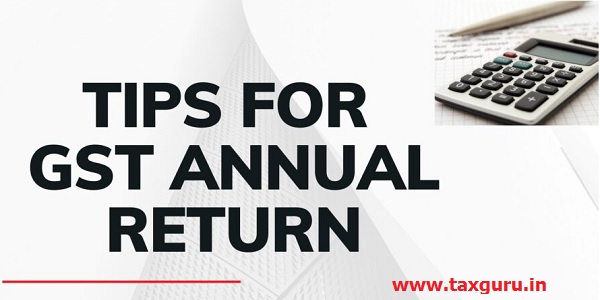Tips for GST Annual Return for the Financial year 2018-2019
Today we will discuss the GST annual filing return for the financial year 2018-19. GST annual return is an annual statement which contains all transactions related to outward and inward supplies in different heads. It contains the following details:
1. Outward Supplies ( Local sale, Interstate Sale, Export, Zero Rated Sale and any other)
2. Inward Supplies ( Input, Capital Input, and Input Service)
3. Inward Supplies which are covered under reverse charge mechanism (RCM)
4. Details of refund claim during the year
5. HSN details of inward and outward supplies.
These are basic details which will you fill in the annual return. Now we discuss important points regarding the annual return.

1. Read the previous year’s Annual Return and Audit Report: First, you have to read the previous year’s GSTR 9 and audit report. You have to check that, there is any point is relevant to the current year especially in case of input
2. Create a reconciliation statement for outward supplies: This is a very important statement. If you create this correctly then your 50% problem will solve. You have to reconcile between (GSTR 1 and GSR 3B), (GSTR 1 and your data), and (GSTR 3B and your software data) and find the difference. You can create this statement in excel or any software. There are many software available in the market.
3. Create a reconciliation statement for inward supplies: This is a statement for reconcile input availed in GSTR 3B and input available in GSTR 2A. This is a very important point. You have to reconcile between (GSTR 3B and GSTR 2A), (GSTR 3B and books of accounts), and (GSTR 2A and books of accounts). You will get the name of registered persons who are not providing you GST input.
4. Prepare details of Table 6A in GSTR 9: Table 6A shows the input claim by you in GSTR 3B during the year. This table does not relate to GSTR 2A. You have to prepare the details of the input claim in GSTR 3B by its nature. You have to split your input in the different column which is as follow:
a. Inputs
b. Capital Goods
c. Input Services
d. Input claim under reverse charge
e. The input of TRAN I and TRAN II.
f. The input of Import of Goods or Services
g. Input tax credit received from ISD
5. Prepare details for Table 8 of GSTR 9: Table 8 shows the difference between the input of GSTR 2A and the input claim in GSTR 3B. Here you have to reconcile whose party doesn’t give you input in GSTR 2A. There are mainly four reasons for any difference you get in this table.
a. Your GSTR 2A shows the input more than you claim in GSTR 3B.
b. Your vendors didn’t give you input in GSTR 2A. This is a common problem for every registered person. You have to reconcile your input sheet and find them.
c. Ineligible Input claim in GSTR 3B: You have to prepare a sheet of ineligible input which was claimed in GSTR 3B by a registered person. For example Input of the purchase of a car, input claim of insurance, input of personal expenditure, and any other. This depends on your nature of business.
d. Any Input of the current year claim in next year: Let suppose you have an expense of FY 2018-19 and you miss to claim input of this expense in the current year. You take this input in FY 2019-20. So this amount will show in TABLE 8.
6. Reverse Ineligible input in Table 7: You can reverse any wrong or ineligible input claim in GSTR 3B in table 7.You can reverse the input under Rule 37, Rule 39, Rule 42, Rule 43, and input claim by TRAN I and TRAN II.
7. Prepare details of any refund claim during the year: A registered person can claim of input or excess cash paid in cash ledger. You have to check the calculation of the refund claim and also check RFD 01 for this. You have to track the total refund sectioned by the department.
8. Any demand paid by a registered person in GST during the year: You have to check any demand paid by the assessee and what was that reason. This is very important for GST annual return and GST audit report.
9. Compare the liability in Table 4 and Table 9: Table 4 shows the data of GSTR 1 and liability paid under the reverse charge mechanism. And table 9 shows the liability which you paid in GSTR 3B. Both liabilities should be equal.
10. Prepare HSN details of Input and Output: HSN is mandatory for whose turnover is more than Rs. 1.5 Crores. So you have to make a sheet for HSN details. You can create this by tally, busy, OR any other software.
These points are the basic points that are applied in every registered business. But when you go for filing GST annual return then you have to get complete knowledge of business and set your own parameters to prepare this return.
“The due date for filing GST annual return for the Financial year 2018-19″
File GST annual return before the due date 31st December 2020 for the financial year 2018-19.




